 Part 1:
Part 1:
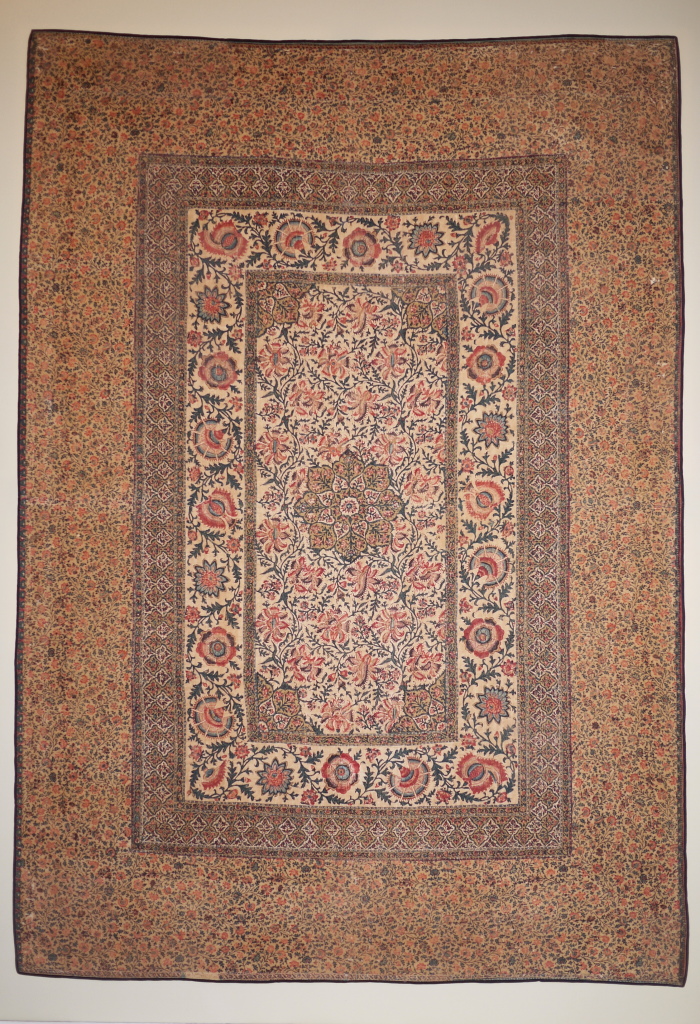 We’re delighted to share with you two posts regarding a wonderful Indian ‘kalamkari’ that we have been conserving and researching over the past few months. In this post, we’ll tell you about a beautiful quilt and the restoration work that we have performed, and next week we’ll discuss its history and the kalamkari genre.
We’re delighted to share with you two posts regarding a wonderful Indian ‘kalamkari’ that we have been conserving and researching over the past few months. In this post, we’ll tell you about a beautiful quilt and the restoration work that we have performed, and next week we’ll discuss its history and the kalamkari genre.
Block printed and hand drawn, this textile treasure of 18th-19th century Indian trade cloth is an old family piece owned by an Iranian American, and little is known about its specific history. Now owned by a very conscientious collector, the piece has come to us to stabilize for mounting and framing, so that it can be safely enjoyed. And at five by six feet, this truly stunning and elegant textile will command any room.
Kalamkari in Sanskrit translates literally as kalam for pen, and kari for drawn – which is how the textile is adorned, along with hand block prints. Concentric floral borders are arranged around a central medallion, much like a Persian rug, this textile seems to call out its Persian destiny.
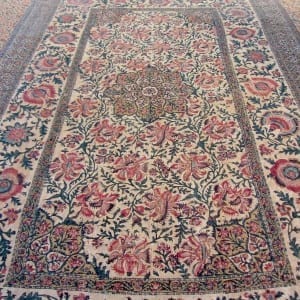 This brittle and papery piece is hand quilted, with a thin batting layer between hand woven cotton block printed face and reverse. The borders exhibit a variety of recognizable flora such as tulips, carnations and thistles, as well as other motifs. The ornamentation is rich with colors of blue, red, green, purple, and black, and a tan background that may originally have been a lighter shade.
This brittle and papery piece is hand quilted, with a thin batting layer between hand woven cotton block printed face and reverse. The borders exhibit a variety of recognizable flora such as tulips, carnations and thistles, as well as other motifs. The ornamentation is rich with colors of blue, red, green, purple, and black, and a tan background that may originally have been a lighter shade.
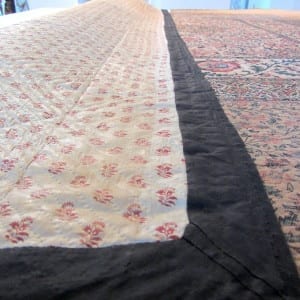 The back is a highly-polished creamy chintz (polished cotton), patterned with small red tulip-like flowers. A bright line between some stitching on the back, indicates the color of the original bright cream chintz, and the former application of a hanging sleeve for display. Intriguing!
The back is a highly-polished creamy chintz (polished cotton), patterned with small red tulip-like flowers. A bright line between some stitching on the back, indicates the color of the original bright cream chintz, and the former application of a hanging sleeve for display. Intriguing!
As our eyes and hands traveled across the quilt, hidden splits and holes were slowly revealed. These damages are unlikely to be from everyday use, but rather from inherent weaknesses and dyes in the fabric, and from light exposure, display, transport, and folded storage. After centuries of devoted gazes, there is minimal damage or soiling. Although the front is deceptively fragile; the back is pristine! In all, about 100 areas were conserved.
- Damage: Kalamkari Restoration
- Damage: Kalamkari Repair
- Damage: Kalamkari Conservation
Our conservation work is as non-intrusive as possible, retaining all original materials, and following the adage ‘less is more’. To begin, the surfaces were carefully vacuumed, and then all the splits, tears, and holes, often in clusters, were marked for treatment. Over these damaged areas, we hand-stitched a sheer netting, or tulle, as a protective overlay. In normal light this netting is nearly invisible; in a raking light it appears like a veil. The diagram of our treatment indicates the netted areas, as well as all the small holes and tears which were delicately tacked using figure-eight and couching stitches with hair-like Skala thread.
 After comprehensive stabilization, the kalamkari was stitch-mounted to a padded and fabric covered support board. Support was provided by stitching around the edge of the piece and also in a grid pattern, so that it can be displayed vertically without any damage. The final step will be to mount with a UF, all-light protective Plexiglass frame, and hung where it can be treasured and admired.
After comprehensive stabilization, the kalamkari was stitch-mounted to a padded and fabric covered support board. Support was provided by stitching around the edge of the piece and also in a grid pattern, so that it can be displayed vertically without any damage. The final step will be to mount with a UF, all-light protective Plexiglass frame, and hung where it can be treasured and admired.
After plying our needles to conserve this beautiful kalamkari for future generations, we set about trying to unravel its past. Come back next week to learn what we discovered, and find out if you will be the one to unlock its final mystery!
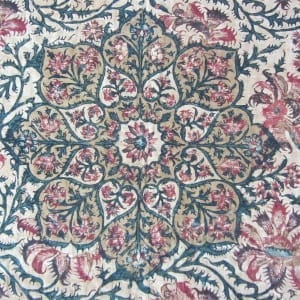
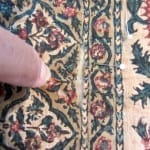
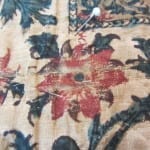
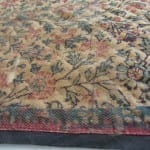

Wonderful article.